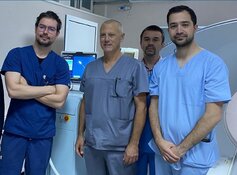The Life Sciences Report: You have worked in the big medical device industry at Johnson & Johnson (JNJ:NYSE), the grandfather of medical technology companies, as well as at a small medical device company. You know this industry inside and out. What are the headwinds facing medtech today?
James Terwilliger: The biggest headwind facing the healthcare industry as a whole, including medtech, is the economy. In the 2008–2009 downturn, we saw procedural volumes stop growing in the U.S. for the first time in years. As investors, we have always said that healthcare represents defensive growth—and it is defensive growth, but discretionary healthcare is also in the mix, and certain procedures can be delayed. Non-emergency orthopedic procedures, where people have pushed hip and knee replacements out 6, 9 or 12 months, are an example of discretionary care. Once people came under financial pressure and began losing their jobs and health insurance, they cut back across the board, including spending on discretionary healthcare. They are delaying surgical procedures as long as possible. We used to look at 4–8% growth in procedural volumes, but now we are looking at 0–3%. I would say that's the biggest headwind.
There are a couple of things I would add. The biggest driver of the industry is going to be new product visibility. We haven't seen significant new products, as we have historically. Looking backward, new products like heart stents came on the market, followed by drug-coated stents. In orthopedics, you had ceramic-on-ceramic hips. You had replacement extremities. But recently we have not seen breakthrough, blockbuster new products that can transform an industry.
Another headwind is the Patient Protection and Affordable Care Act (ACA/Obamacare), which has been in the headlines for quite some time. No one is 100% sure what the program will look like ultimately. Challenges to the law went all the way to the Supreme Court, which put a cloud over healthcare as a whole from an investing standpoint. The industry's macro headwind might be Obamacare, because of the lack of visibility looking into the future.
TLSR: I'm not trying to be Pollyannaish here, but everything you have said indicates we are still in a weak period in medtech. Could this make for strong comparisons (comps) in a year or two?
JT: Absolutely. That is why we should stay invested and continue to look at these stocks. You are 100% correct in recognizing that, if you take into account the easy comps that these companies have today, and then factor in the biggest driver for the investment thesis in this space, which is an aging population, we believe the turnaround could be very, very significant on the other side of this downturn. When these companies beat the easy comps, and when we see the return of the historical 4–6% growth rate in surgical procedures, that will represent significant increases in value.
TLSR: Does that portend earnings surprises?
JT: Yes, but I don't think there will be surprises on the upside in the near term. In fact, we have taken a very cautious stance in H2/12, and into 2013, because the European slowdown is just beginning to hit a lot of healthcare companies. It hasn't hit U.S. healthcare companies yet because we are a little bit defensive.
TLSR: What does a small medical device company have to do to succeed in this environment?
JT: That is a catalyst question. Our investment thesis focuses on a couple of catalysts. We look for companies launching new products. They don't have to be blockbusters, but new product visibility is key. What was driven into me at Johnson & Johnson was that a new product is something that medtech sales staff could talk about with clinicians. Face time with physicians is hugely important, because a new product doesn't drive new business itself. It also puts the medical device sales force in a position to do product pull-through with other products.
TLSR: What factors and features do you look for when you look for stories that can make money for investors?
JT: I look for a good balance sheet, a good cash and net-debt position. I look for dividends. I look for stock buybacks.
The balance sheet can truly represent the history of the company. When we had the downturn in 2008–2009, the only stocks that held value were those that had very, very strong balance sheets. When a company has cash and low net debt, it does not have to approach a bank for a loan. The company has the ability to buy back stocks, pay a dividend or acquire another company. With small companies, I also look for good management teams that can grow and execute.
In this current environment, I encourage investors to look at companies doing more business in the U.S., not less. Back in 2008–2009, companies going global were attractive. That's all anyone was talking about at the time. Now Europe is in trouble, and Asia is slowing down. Here in the U.S., we appear to be pulling out of the downturn. We are coming back faster than some of the emerging markets.
Investors also must look at the question of valuation. You can have a great company, but the stock may be too expensive. You can also have a good company with stock that is dirt cheap. Valuations are extremely important when you are selecting companies.
TLSR: You follow outsourcing services. What is your investment theory here? What are the global drivers feeding this industry?
JT: Obamacare contains initiatives like the medical device tax, which takes effect on Jan. 1, 2013. While we don't consider the tax significant, it is going to be a hit to the margins, and it will weigh on the valuations that investors give medtech companies. We also believe the businesses, whether hospitals or medical device companies, are going to have to take a good look at how they can improve their cost structures.
TLSR: How do you play the thesis of improving cost structure?
JT: I will give you a good example. We cover Healthcare Services Group Inc. (HCSG:NASDAQ), which provides laundry, linen and food services to long-term care facilities, nursing homes and hospitals. Providers like Healthcare Services Group are looking at Obamacare and asking if it might cut reimbursement rates. How do they tighten their belts and improve their cost structures? I think medical device companies are looking at the ACA and asking, "How can we cut costs to make up for this tax?" They could look to outsourcing things like manufacturing. We think many providers will outsource certain nonessential, nonclinical services. Because of this, Healthcare Services Group has been a great stock.
TLSR: Can you elaborate on your outsourcing theme with Healthcare Services Group?
JT: The company has grown its revenue historically in the range of 10–15%. Over the last three or four quarters we have seen top-line growth from 20–25%, and most of that is internal. Here are a couple of quick bullet points: The company has cash on the balance sheet and does not have any debt. It has a stock buyback and a dividend program yielding approximately 3%. And 99% of its business is U.S.-based.
Currently, the company is seeing significant growth in its food service business. Long-term care facilities are outsourcing housekeeping and food services to Healthcare Services Group because they have better control. They know who to call if there is a problem. Healthcare Services Group has thousands of customers and can take advantage of economies of scale. The company makes a profit and provides cost savings to the facility. It's a great stock that has worked well for us.
TLSR: What about a medical device company?
JT: Cardiovascular Systems Inc. (CSII:NASDAQ) is a single-product, catheter-based company in the peripheral artery disease (PAD) market. Its catheter can clean out blocked arteries in the leg. The product is approved in the U.S., and all of its revenue comes from the U.S. The product has also been approved for use in Europe, but it hasn't launched there yet.
The company is currently doing a clinical trial, taking the same technology to the heart to clean out blocked coronary arteries. We think there is a great chance that the product will get approved for that indication. It will then seek European approval for the cardiac indication. Before it's over, we think the company will have both the PAD and cardiology markets in both Europe and in the U.S. This is a small company, and it is a very nice new-product visibility story.
TLSR: I know you've spoken with some of the interventional cardiologists who are participating in the trials and translating the company's orbital system to atherectomy of coronary arteries. Is it easy to use? Is it more technique-sensitive than what the cardiologists are used to?
JT: It will only be difficult from the perspective of changing practice patterns. Right now, when there are blockages in the coronary artery system, cardiologists perform balloon angioplasty and stent placement. Cardiovascular Systems' orbital product spins around—it is called differential sanding. It grinds down the blockages, which are released into the bloodstream and are cleaned the way the body naturally cleans blood. Cardiovascular Systems claims the debris is the size of red blood cells. Some cardiologists will jump to the new technology, but those who are very established in their practice patterns won't jump.
The nice thing is that cardiologists are very familiar with catheters, so there is not a huge learning curve associated with this technology. It will be quick to learn. Remember, when you put in a balloon and a stent, all you're doing is pushing the debris against the walls of the artery. The Cardiovascular Systems product actually grinds up and removes the debris.
TLSR: What's your next idea?
JT: The next one is ICU Medical Inc. (ICUI:NASDAQ). This is a very interesting story, and the stock has been a great performer. ICU Medical's main business is making intravenous (IV) connection systems. It's a closed system, and ICU Medical was one of the first companies to come out with a needle-free system. This is a huge market. Any time a patient goes for a procedure, or is simply admitted to the hospital, he or she is likely going to end up with an IV. Once an IV system is used, what do you do with it? You throw it away and buy a new one. ICU Medical is an outstanding, defensive-growth story.
The company has very good cash flow. When you look at the balance sheet, it is absolutely pristine. It has more than $10/share in cash. It has no debt. It does have a stock buyback. A lot of investors would like it to pay a dividend, but it's very comfortable just letting cash accrue on the balance sheet. What a great problem to have; I wish all my companies had that problem.
TLSR: The company is very dependent on Hospira Inc (HSP:NYSE). I know it loves the business Hospira gives them, but I wonder if ICU Medical is trying to diversify away from that.
JT: Absolutely. Its relationship to Hospira is the risk to the story, because Hospira is a huge customer. Going into the oncology market for infusions is going to lower ICU Medical's reliance on Hospira. Also, ICU has increased its internal sales force, and it is going out to different distributors. There is risk in the story, and it is significant. Still, the company has been lessening its dependence on Hospira, though it is still very much dependent.
TLSR: Your next idea?
JT: I would like to talk about Vascular Solutions Inc. (VASC:NASDAQ). This catheter-based company has a number-one product line with a market of about 2,000 big-time cath labs in the U.S. It is a very small company that developed a U.S. sales force years ago. It has a balance sheet with no debt. It has a net-loss carry forward, so it is not paying taxes and its cash flow is strong. Most Wall Street investors fully tax these estimates, and we do that with our earnings per share estimates, but in reality the company isn't paying taxes. It has more cash coming onto the balance sheet, and is buying back its own stock.
Vascular Solutions is not a gross-margin improvement story. The real key is seeing an operating margin improvement because the sales force, covering 2,000 cath labs, has a platform from which it can grow the company. Hopefully, as it gets new products on its platform, it will not have to add expenses because the sales force is in place. It will get leverage on the sales and marketing side, which will help improve operating margins. Thinking back to the desirable characteristics we talked about earlier, Vascular Solutions has all of them.
TLSR: Vascular Solutions has a $211 million (M) market cap, and had just less than $11M on the balance sheet at the end of last quarter. That's not a lot of cash. Why is a company of this size buying back its stock? Is this the best investment it can make with that cash?
JT: Remember, no one is getting interest income on cash right now. The company thinks its stock is undervalued, so it is buying back its stock. What the company would like to do is get the share price up and then split the stock, thereby getting more liquidity. It is also using its cash to do some very small product acquisitions. It recently acquired a catheter-based product from St. Jude Medical Inc. (STJ:NYSE). It is doing everything it can to help the shareholders. It's nice to see a company doing a stock buyback when there's not that much liquidity in the market and when volumes are so thin. I don't see any large acquisition for the company to do.
TLSR: What's your next idea?
JT: Exactech Inc. (EXAC:NASDAQ). It is similar to Vascular Solutions, having a market cap of about $222M, except that it is an orthopedic player. The procedural slowdown has been difficult for the orthopedic industry, but this company has one of the fastest growth profiles in the industry. Exactech is a small company started by an orthopedic surgeon, and its key product is knees. All the growth in orthopedics is coming from companies producing extremity orthopedic products, such as Exactech. In Q2/12, Exactech posted growth in excess of 20% in both its extremities product line and its hip product line. When you look at the orthopedic industry as a whole, nobody is putting up growth like that. Exactech is a nice little company.
TLSR: James, I noted that Exactech's biologics and spine business was down 13% in Q1/12 versus Q1/11. Is Exactech deemphasizing biologics and spine?
JT: No, it is not. The biologics and spine business across the board has been hit very hard over the last five years, and Exactech is being hit just like every other spine company in the industry. Back surgery is arguably one of the worst surgeries a patient can have. The company got into spine because it was a hot market at the time, but it has decelerated, both in terms of procedures and also in pricing. But Exactech is doing a great job with its extremities product line. Even though it's a small-cap company, it's diversified. I would say it is firing on three of its four cylinders right now.
TLSR: Exactech made a commitment in Spain and is selling direct there. Given conditions in that part of Europe, it sounds risky. Why did it choose Spain?
JT: Spain is not that big, and there are just a few big cities, so a company can cover the territory easily. Exactech had a distributor there, but it thought it could do better by going direct. Remember, when it made that decision in 2008–2009, everybody said companies had to be global and had to be selling in all of the international markets. Now, unfortunately, we know what's going on with Europe, and in Spain. That is a risk to the story. You identified the two risks—the spine/biologics business and going direct in Spain. Those are two headwinds for this company.
TLSR: The stocks we've talked about so far are all Buy- or Speculative Buy-rated. But I'm noting that you have two Hold-rated companies. Do you want to tell me their stories?
JT: Our Hold-rated stories are Symmetry Medical Inc. (SMA:NYSE) and Tornier Inc. (TRNX:NASDAQ). Tornier went public in early 2011. Very few companies could have gone public in this type of market, but this is a great company. It is a market leader in extremities—shoulders, elbows, wrists, hands, ankles and feet—an area where you find growth. That said, we downgraded the company in July because of its exposure to international markets. We were concerned about growth slowing down in orthopedics as a whole and for Tornier because of its exposure to Europe, where the company has a direct sales force. About 47% of its business comes from international markets, and we downgraded it based on our due diligence phone calls and channel checks. When it put numbers out in early August, it missed Q2/12 estimated results and lowered guidance for the year, and the stock got hit pretty hard. We still think it is a good company, and we think it is a takeover candidate, but we don't see any improvement coming from Europe.
Symmetry Medical is very similar. Its core business and history has been in original equipment manufacturing (OEM) in the orthopedic space—hips, knees and extremities. It has an implant business, which makes products for Johnson & Johnson. It is trying to go through a transformation and develop in-house proprietary products under the Symmetry Surgical umbrella. Symmetry is not doing anything wrong; it's just this environment.
TLSR: Somebody likes Symmetry. It's up 15% over the past three months, whereas Tornier is down 14% during that same period. They are mirror images of each other in recent performance.
JT: I think some investors are looking for a turnaround. How does the turnaround happen? We know the OEM business is going to be poor. But people do like the December 2011 acquisition of Johnson & Johnson's surgical instrument business, Codman & Shurtleff. I am concerned about the stock because I think the OEM business is going to be challenged. It is still declining. Except for the easy comparisons that we talked about earlier, I don't see a big uptick on that. We do like the company, but as you said, the stock has had a move, but I'm going to stay on the sidelines on this one.
TLSR: Many thanks to you, James.
JT: Thank you. I enjoyed it.
James Terwilliger joined The Benchmark Company in January 2012 to cover small- to mid-cap medical device and healthcare services companies. He has more than 10 years of equity research experience covering companies in the cardiology, oncology, orthopedics, technology and service sectors. Previous to working with Benchmark, Terwilliger was the executive managing director of healthcare research at Duncan Williams Inc. His other Wall Street affiliations include Morgan Keegan & Company, Sander Morris Harris Inc. and Needham & Company. Terwilliger's healthcare industry experience includes sales and marketing with Johnson & Johnson Healthcare Systems Inc. and as a healthcare consultant for Ernst & Young. He was also president of Neurorecovery Inc., a biopharmaceutical company focused on neurological conditions. In 2005, Terwilliger was recognized by The Wall Street Journal as an All-Star Analyst for stock price performance for medical devices and equipment. He was also recognized in 2002 by StarMine as one of the top medical device analysts for earnings accuracy. Terwilliger holds a master's degree in public health from Yale School of Medicine with a focus on healthcare management and healthcare finance.
Want to read more exclusive Life Sciences Report interviews like this? Sign up for our free e-newsletter, and you'll learn when new articles have been published. To see a list of recent interviews with industry analysts and commentators, visit our Exclusive Interviews page.
DISCLOSURE:
1) George S. Mack of The Life Sciences Report conducted this interview. He personally and/or his family own shares of the following companies mentioned in this interview: None.
2) The following companies mentioned in the interview are sponsors of The Life Sciences Report: None. Johnson & Johnson is not affiliated with Streetwise Reports. Streetwise Reports does not accept stock in exchange for services. Interviews are edited for clarity.
3) James Terwilliger: I personally and/or my family own shares of the following companies mentioned in this interview: None. I personally and/or my family am paid by the following companies mentioned in this interview: None. I was not paid by Streetwise Reports for participating in this interview. My coverage universe, with ratings, includes: CSII (Speculative Buy), EXAC (Buy), HCSG (Buy), ICUI (Buy), SMA (Hold), TRNX (Hold), VASC (Buy).




































